A snapshot of DeFi
In the midst of a broad crypto bull market, DeFi has continued its strong rise. Beginning in summer of 2020, DeFi projects saw significant growth in Total Value Locked (TVL). Around the Block previously explored DeFi and the Yield Farming phenomenon in June 2020, but what’s happened since?
To put it simply, DeFi’s meteoric rise has continued. As we noted last time, growth is still spurred by the yield farming phenomenon. This includes a virtuous cycle: Yield farming mechanics induce participants to add capital → which increases TVL → which drives governance token valuations → which increases yield farming subsidies → which continues the cycle.
Nevertheless, true zero-to-one innovations in DeFi cannot be discounted as part of the growth story. These are things like synthetic assets (e.g. Synthetix, UMA, and Mirror), increased capital efficiency in financial products (e.g. Aave, Compound), open financial access (including flash loans and emerging remittance use cases), and composable protocols that layer DeFi projects together like Yearn, among many other things.
Total Value Locked in DeFi protocols (TVL) now stands above $25B, an incredible 2500% growth Y/Y. Similarly, the number of DeFi users has surpassed 1.2M, as defined by the number of unique addresses accessing DeFi services. Mainstream protocols like Uniswap and Compound claim 200–500K users, with most other DeFi apps between 25–50K users.
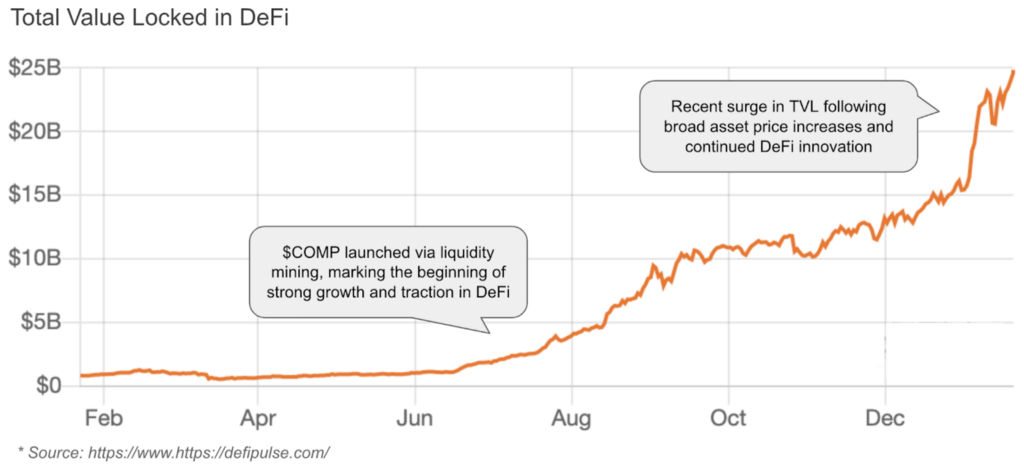
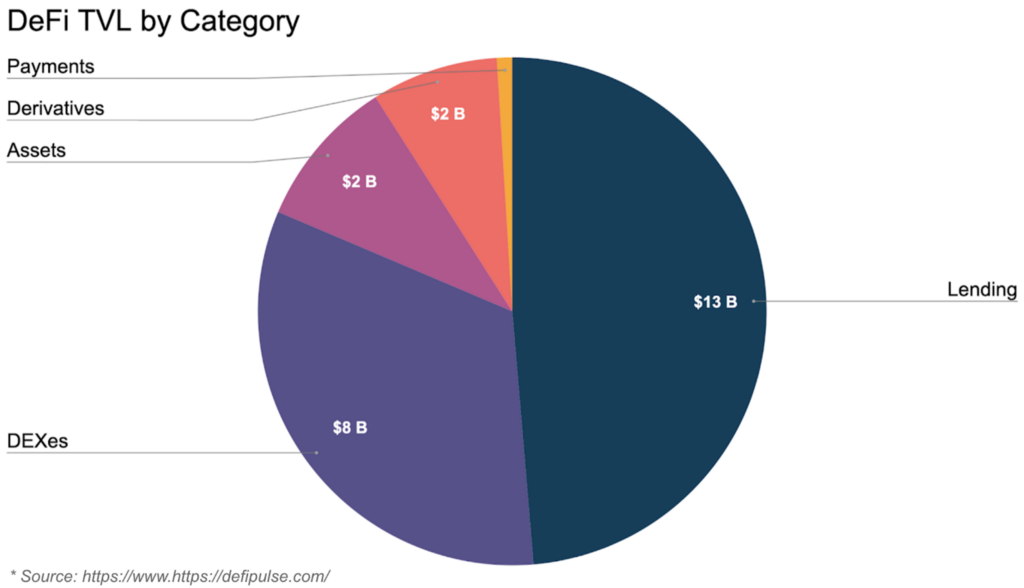
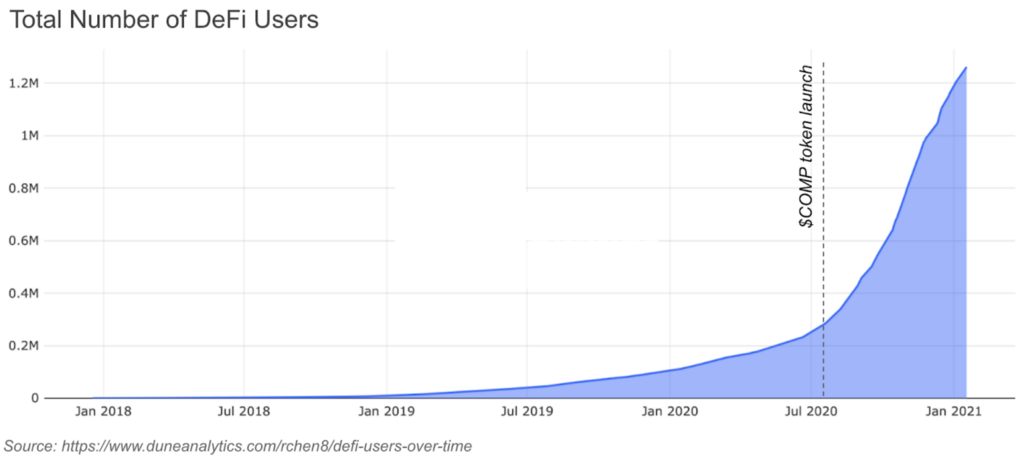
Similarly, DEX volume has continued its strong growth since July 2020. Cumulative DEX volume now surpasses most centralized exchanges, topping $10B per day in January 2021.
Volume has been driven by growth in DeFi, but also tailwinds from broader crypto bull markets and sustained traction in categories where DEXs enjoy competitive advantages. These include access to the long-tail of novel DeFi tokens; and efficient swaps between highly correlated assets (e.g. stablecoins).
However, DEXs today settle trades on the main Ethereum blockchain, and are thus subject to oppressive gas prices in periods of high demand. This drives continued interest in scaling solutions, with a notable milestone as Synthetix has launched on Optimism (a rollup-based scaling solution).
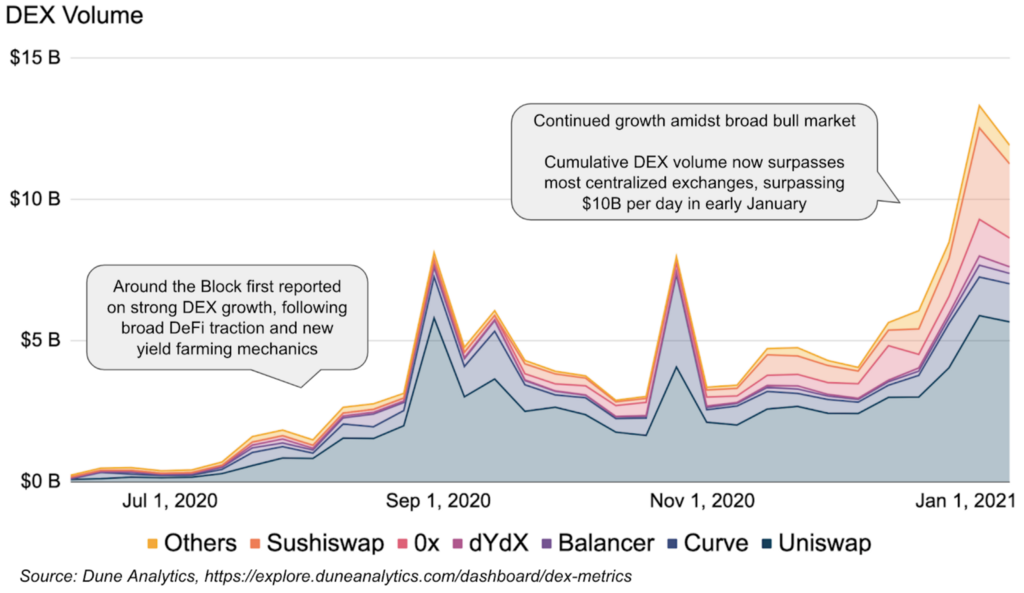
While looking at top-line metrics is encouraging, the fact remains that DeFi is moving too quickly for any single person to keep track. Here are some high level themes we find interesting:
DeFi projects are embracing composability: New DeFi projects either introduce new primitives, or bundle existing primitives to create net new products. Think of these primitives as lego bricks, 6 months ago we were designing and building single bricks. Today we are combining these bricks into cars, planes, and castles.
Composability is extending into DeFi versions of partnerships: DeFi projects are wrestling with key questions around moats, defensibility, and top-line growth. Most projects seem to embrace open community collaboration, believing communities create moats (you cannot fork a community). This exact vision initially led to the governance token and yield farming phenomenon, and today is evolving into creative partnerships and collaborations, most notable in Sushiswap’s 2021 roadmap.
Scalability is becoming a bottleneck, but solutions are coming: As the base Ethereum chain struggles under scale, several protocols are openly exploring integrations with Layer-2 networks or other blockchains. Look for significant progress in 2021, especially in Ethereum rollups.
Regulatory uncertainty impacts development: In tandem, the SEC lawsuit against Ripple and CFTC lawsuit against BitMEX demonstrate that regulatory bodies are paying close attention to crypto, and not afraid to charge the largest players in the space. It’s reasonable to expect increased attention on DeFi based projects, and this uncertainty continues to impact feature development in regulated jurisdictions.
Speaking of regulation….
Two sides of the regulatory spectrum
Over the past quarter, both FinCEN and the OCC have come out with crypto regulatory guidance. Even though both are under the purview of the US Treasury, the guidance seems to be on the opposite ends of the spectrum toward crypto friendliness.
FinCEN
FinCEN is responsible for adherence to KYC/AML laws, which are especially important for crypto exchanges (“VASPs — virtual asset service providers”) like Coinbase. Crypto exchanges are required to verify their customer’s identities (KYC) and use blockchain forensic tools to study crypto transactions in order to ensure deposits do not come from potentially illicit sources.
FinCEN recently proposed an amendment to the Bank Secrecy Act’s FBAR regulations, specific to cryptoassets and VASPs. In summary, under the new amendment, US citizens would have to report crypto holdings and transactions greater than $10K regardless of where the cryptoassets are held. To summarize, the amendment would essentially require US individuals to report crypto holdings in excess of $10K that are held in foreign accounts, and require crypto exchanges or wallets to store customer information related to any transaction above $3K, and report this information to FINCEN for any transaction above $10K.
Additionally, the public notice had a limited 15 day comment period over the U.S. holiday break, which made it potentially difficult for crypto service providers to respond.
Many crypto service providers ( Coinbase, Fidelity, Square, CoinCenter, ErisX, among others) have come out with strong responses arguing against the proposed rule, highlighting (among other things) the rushed nature of the proposal and inadequate time to address questions.
Since then, the Treasury has extended the comment period, and the future remains unclear given the new administration.
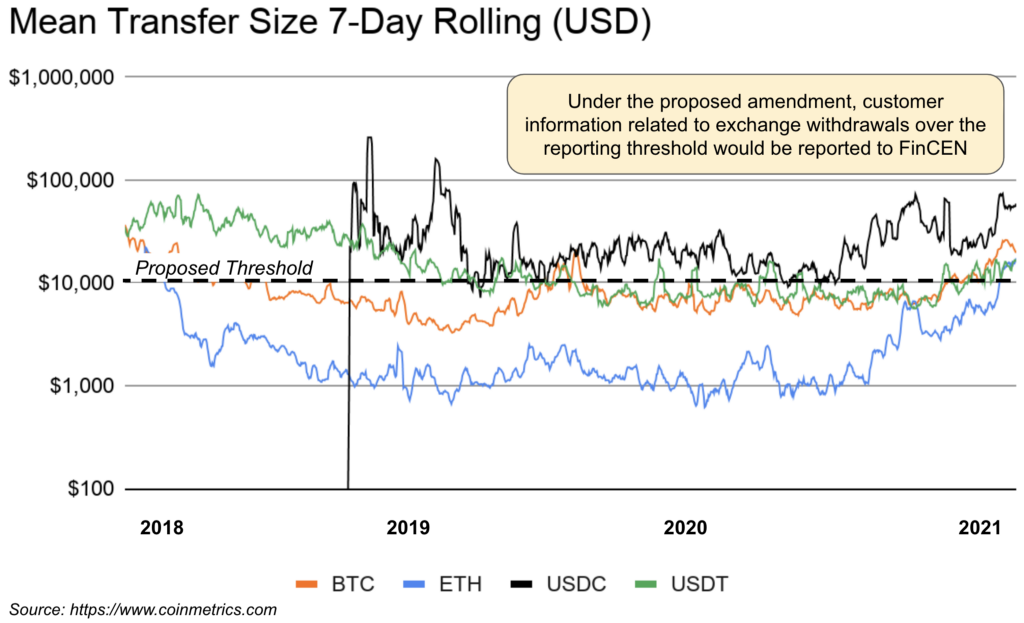
OCC
The Office of the Comptroller of the Currency (OCC), an independent bureau in the Treasury with a mandate to help “charter, regulate, and supervise banks,” came out on the other end of the spectrum with recent guidance:
Federal Banks may run public blockchain infrastructure [ Jan 2021]
Federal Banks may engage in stablecoins [ Sept 2020]
Federal Banks may custody crypto-assets [ July 2020]
With this string of positive guidance, it’s clear that national banks may now participate in the crypto economy through custody and settlement. Notably, Jan 2021 guidance which legitimizes public blockchains as settlement infrastructure, placing blockchains on par with ACH or SWIFT.
In other words, federal banks can serve as large validators on blockchains (e.g. miners), or more practically, banks may ultimately settle transactions on Bitcoin, Ethereum, or through stablecoins.
Ultimately, this is the first step in regulatory action required to bridge the crypto economy into traditional financial infrastructure. Note also that while the OCC is the federal regulator, it is not the only regulator. There will be an interplay between the interpretation of this guidance from the state vs federal level. Separately, adoption will take time — blockchains are still relatively new and lack some core features (e.g. privacy, scalability), but this is a promising development.
To their credit the Treasury has since extended the comment period, and the proposal potentially hangs in limbo with the incoming Biden administration.
Coinbase news
Retail
Institutional
Crypto-friendly Gensler is nominated as head of SEC by Biden
Anchorage receives conditional approval for national crypto-bank charter from OCC
Ecosystem
The opinions expressed on this website are those of the authors who may be associated persons of Coinbase, Inc., or its affiliates (“Coinbase”) and who do not represent the views, opinions and positions of Coinbase. Information is provided for general educational purposes only and is not intended to constitute investment or other advice on financial products. Coinbase makes no representations as to the accuracy, completeness, timeliness, suitability, or validity of any information on this website and will not be liable for any errors, omissions, or delays in this information or any losses, injuries, or damages arising from its display or use. Unless otherwise noted, all images provided herein are the property of Coinbase.
This website contains links to third-party websites or other content for information purposes only (“Third-Party Sites”). The Third-Party Sites are not under the control of Coinbase, and Coinbase is not responsible for the content of any Third-Party Site, including without limitation any link contained in a Third-Party Site, or any changes or updates to a Third-Party Site. Coinbase is not responsible for webcasting or any other form of transmission received from any Third-Party Site. Coinbase is providing these links to you only as a convenience, and the inclusion of any link does not imply endorsement, approval or recommendation by Coinbase of the site or any association with its operators.
was originally published in The Coinbase Blog on Medium, where people are continuing the conversation by highlighting and responding to this story.

